Varaha Jayanti 2023: Date, Time, Rituals, Celebrations and Significance
Article Rating
☆☆☆☆☆ 3.8/5
The Varaha (boar) form, one of his most famous avatars, is thought to be Lord Vishnu’s third incarnation on Earth. Varaha Jayanti is a celebration commemorating the birth of Vishnu, one of the most powerful Gods to walk the planet, along with Brahma and Mahesh (Lord Shiva). According to legend, Lord Vishnu reincarnated as a boar to preserve the universe from the scourge of two great demons who threatened to disrupt the peace of all three worlds.
On this day, which falls on the second day or Dwitiya Tithi in the Shukla Paksha of the Magh month, devotees worship Lord Vishnu. Vishnu, known in Hindu mythology as the protector of all realms, is revered across the country by followers who believe in his various forms.
Varaha Jayanti Date 2023
Sunday, 17 September 2023
In Hindu mythology, worshipping Lord Varaha bestows vast wealth and good health on the subject. Lord Vishnu, reborn as half-human and half-boar, went on to defeat two of the most powerful demons who had afflicted all three planets. The prayers offered on this day are thought to ward against evil and bless you with a happy life.
Varaha Jayanti Rituals
Varaha Jayanti is primarily celebrated in South India. Early in the morning, after the devotee has had his wash, prayers are offered. Devotees might visit a temple dedicated to Lord Vishnu or a place of devotion of their choice at home. The following ceremonies are performed to commemorate the day:
- Lord Varaha (Vishnuidol )’s is housed in a metal pot (Kalash).
- Mango leaves are soaked in the kalash, which is filled with water. A coconut is placed on top and given to a Brahmin.
- The Shrimad Bhagwad Gita was recited aloud by the devotees.
- On the eve of Varaha Jayanti, those who observe a Varaha Jayanti fast are obligated to offer clothes and money to the needy.
- It is thought that giving to the underprivileged and needy aids in obtaining Lord Vishnu’s blessings.
The legend behind Varaha Jayanti
According to the Puranas, Diti, one of Kashyapa’s (a sage’s) thirteen wives, gave birth to two extremely powerful demons named Hiranyakashipu and Hiranyaksha. Holika, who turned out to be an evil demon and whose burning is commemorated as Holi – the festival of colours – was also conceived in her womb. Both male offspring grew up to be powerful men, but they chose the path of adharma over dharma. Hiranyakashipu and his brother Hiranyaksha invoked Lord Brahma, whom they pleased with their unwavering faith and unending petitions. When Lord Brahma appeared and invited them to make a wish, they asked the creator of the worlds to make them invincible in any dimension.
After Lord Brahma fulfilled their wish, Diti’s two sons went on a rampage over all three worlds. Legend has it that the two brothers went on to conquer the three worlds. But their desire for greater destruction was unquenchable. That’s when they set out towards Lord Varuna’s dominion, then known as Vibhaari Nagari. Lord Varuna warned the two asuras (demons) to remain away from the kingdom, reminding them that Lord Vishnu is their guardian angel and the protector of the universe, and that they would never be able to vanquish him.
Enraged by his insult, Hiranyaksha set out to find Lord Vishnu in order to destroy him and claim the invincibility bestowed upon him by Lord Brahma. Lord Varaha was reborn as Lord Vishnu by the time he discovered Lord Vishnu. Hiranyaksha is said to have witnessed Lord Varaha balancing the earth on his tusks at this point. Lord Varaha then kills Hiranyaksha in a battle, putting an end to the reign of terror he and his brother had unleashed. People began to believe in Lord Vishnu’s third incarnation as a wild boar on this day. Since then, they have been worshipping Lord Varaha and fasting on Varaha Jayanti to keep evil at bay and to live a dharmic life in service to others.
Varaha Jayanti Celebrations
On Varaha Jayanti, an ancient temple in Mathura dedicated to Lord Varaha hosts one of the largest festivals. Bhu Varaha Swamy Temple at Tirumala is another temple popular for celebrating Varaha Jayanti. Offerings are made to Lord Vishnu’s idol on the eve of this event. Coconut water, milk, honey, butter, and ghee are among the offerings.

